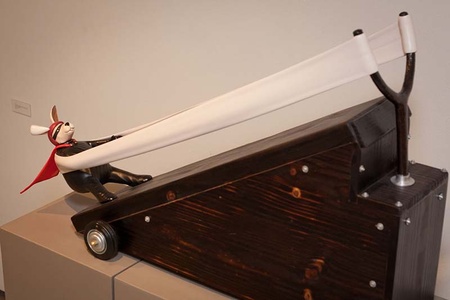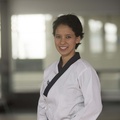When we become adults, do we become too rational, and, [as a result] our imagination wanes?
We cannot speak in generic terms; it is not something that happens to everyone. But yes, I believe that we have to be more rational because of our survival instinct. Life doesn’t demand reasons, and you find a logic to all of your actions. But we don’t have to cast everything as a dichotomy—black or white—the rational being would not have to dream small. You can have the ability to dream and then have a more rational side that can help you make those dreams a reality. The point is that we are going to lose this search to realize our dreams by living day to day, or by just surviving. I believe that the small things such as music, dance, a good book or movie, an exhibition, help us to leave behind the daily grind that can be monotonous, tedious, at times. Such things refreshen us and direct us to the more recreational [things in life].
When you go to the movies, do you not feel that you are lifting your feet off the ground, but when the movie ends “you have landed back into reality?”
But you return different. You are going to see a play at the theater and suddenly, during that hour and a half, two hours, you ecome engrossed in the situation that is taking place in front of you. You get caught up in the plot, you live the pain, the passion. Yes, the play ends and you return to your daily life, but in those two hours your mind was in another place.
Do you miss the ability that children have to harmonize in their world the possible and the impossible, to bring together fantasy and reality in such a natural way?
Yes. A child spends more time sleeping than we do. As we get older we sleep less. Children live much more connected with the dream world, with the fantasy world; therefore, it is more probable that they can visualize things in a more creative way, that they can imagine a world that is not subject to logic. A child can easily believe that his dog can talk.
You have said that when you were a child they told that you were a daydreamer.
Yes—in math and geography class—I have always been somewhat scattered, having a hard time focusing. Not with reading but almost always with numbers. It was inevitable. But when they told me that I was daydreaming, what fascinated me most were those images of the astronauts floating around and spinning. When they told me that I was daydreaming, instead of saying “Hey, yes, I am distracted, I have to focus,” worse, I began to daydream even more. I never took it as negative when they told me that I was daydreaming.
When you find yourself in a daily activity, for example, at a meeting, do you ever leave reality and begin to fly?
Yes. My mind goes to another place, at times I imagine sculpted pieces that I have not yet finished, and I leave them in a safe place, such as an archive that is inside my head. I am in the middle of a meeting, or on the bus, walking, or reading the newspaper, and suddenly I stop and it is as if the file has opened by itself, and I say “yes, if I do it this way, if I assemble this here.” And if I can, I make note of it because if I don’t, well, I’ll forget it. Yes, there are moments when my mind breaks free and flies. What’s more, part of this sculpture was born a little like that…sitting on the bus, playing with the ticket, I made an airplane and I imagined myself seizing the airplane, and it was then that I knew what the sculpture was going to be. I arrived home, made a sketch of the piece, and left.
They are ideas that pop up suddenly.
I don’t know whether or not I believe in inspiration as if it was something magical that comes and “poof,” but yes, I firmly believe that you have to be working.
You are not going anyplace if you are twiddling your thumbs.
Yes. When I have a project, I spend hour after hour, night after night drawing, firming up the concept…the sculptures that are going to provide the thematic core. Other ideas pop up that I jot down, which I then turn into sketches on another day. That is how the exhibition takes shape, through major works of sculpture and then other pieces take shape, giving support to the whole project.
Why is the protaganist a wild boar?
There are people who ask me why I make animal sculptures. For me animals symbolize many things, among them this question of instinct, at our level but even more basic, more elementary, less complicated, that makes us do things less for reasons of convenience, which means we are calculating things less often. Use of the wild boar, well, I had done a pig before. The pig was completely domesticated, terribly exploited by humans. A wild boar, on the other hand, is wilder, freer, [and] untameable.
In “Zoociety,” characters such as the bus driver or politician, who are unpleasant folks, upon being transformed into animals, they become friendly. Becoming an animal is humanizing.
There is a paradox. I am taking the animals and making them human. I am representing human beings that at times are seen as savage due to the violence that engulfs us. The crazy part about it, though, is to travel the opposite way, to take these fantastic characters and represent them as animals, [and] we become docile.
Characters that draw your affection.
It is to seek out the most recreational side [of life]. I also believe that when we see representations of animals, we make an instinctive connection almost immediately. As such, these characters—who come somewhat agressive from our daily lives—transform into my language of animals. We become even closer to them, even intimate. One of the sculptures that people like is that of the parakeet, which represents a thief. Who’s going to relate to a thief, but the sculpture of the parakeet is quite intimate. This transformation gives it another character. I like to inculcate these kinds of things in my sculpture. If it prompts a smile, I will be well served, and if it provoke questions, even better.
*This article was published thanks to an agreement between the Japanese-Peruvian Association and the Discover Nikkei Project. It was published originally in the journal Kaikan, volume 52, December 2010, and adapted for Discover Nikkei.
© 2011 Asociación Peruano Japonesa / Fotos: Asociación Peruano Japonesa / Fernando Yeogusuku











